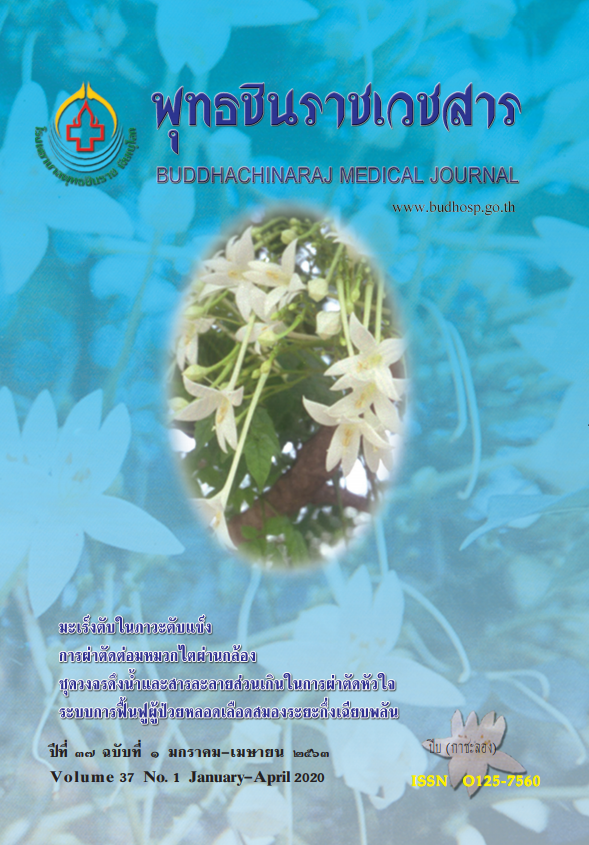การกำหนดขอบเขตก้อนมะเร็งด้วยวิธี SUV 2.5 สำหรับ 18F-FDG PET ในมะเร็งปอด
การกำหนดขอบเขตก้อนมะเร็งในมะเร็งปอด
คำสำคัญ:
เพท, การกำหนดขอบเขตก้อนมะเร็ง, การวางแผนการรักษา, มะเร็งปอดบทคัดย่อ
มะเร็งปอดเป็นสาเหตุของการเสียชีวิตสูงที่สุดของโรคมะเร็งทั้งหมด ปัจจุบัน 18F-FDG PET/CT มีบทบาทสำคัญในการกำหนดขอบเขตของก้อนมะเร็งในขั้นตอนการวางแผนการรักษาด้วยรังสี การศึกษาแบบย้อนหลังนี้ มีวัตถุประสงค์เพื่อประเมินการกำหนด ขอบเขตของก้อนมะเร็งจากภาพถ่ายรังสี 18F-FDG PET ด้วยวิธี SUV 2.5 จากแผนการรักษาผู้ป่วยมะเร็งปอดที่เข้ารับการรักษา ระหว่างเดือนธันวาคม พ.ศ. 2554 ถึงเดือนธันวาคม พ.ศ. 2559 จำนวนทั้งหมด 18 คน กำหนดขอบเขตของก้อนมะเร็งด้วยวิธี SUV 2.5 กับการวาดด้วยมือของรังสีแพทย์ หาค่าปริมาตรค่าเส้นผ่านศูนย์กลางสมมูล และค่าดัชนีความเหมือนของก้อนมะเร็ง นำเสนอ เป็นค่ามัธยฐาน ค่าเฉลี่ย และค่าเบี่ยง เบนมาตรฐาน เปรียบเทียบค่าที่ได้ระหว่างทั้งสองวิธีด้วยการทดสอบ paired t, Wilcoxon signed rank รวมทั้งการหาความสัมพันธ์ด้วย Pearson correlation coefficient (r) กำหนดระดับนัยสำคัญทางสถิติที่ 0.05 พบ ว่าค่ามัธยฐานของปริมาตรของก้อนมะเร็งจากวิธี SUV 2.5 (41.21 ลูกบาศก์เซนติเมตร) เล็กกว่าการวาดด้วยมือของรังสีแพทย์ (51.59 ลูกบาศก์เซนติเมตร) อย่างมีนัยสำคัญทางสถิติและมีระดับความสัมพันธ์สูง (r = 0.929) เช่นเดียวกับค่าเฉลี่ย ของเส้นผ่าน ศูนย์กลางสมมูลของก้อนมะเร็งจากวิธี SUV 2.5 (4.45 ± 1.53 เซนติเมตร) สั้นกว่าการวาดด้วยมือของ รังสีแพทย์ (4.97 ± 1.84 เซนติเมตร) อย่างมีนัยสำคัญทางสถิติและมีระดับความสัมพันธ์สูง (r = 0.952) สำหรับค่ามัธยฐานของค่าดัชนีความเหมือนเท่ากับ 0.57 สรุปได้ว่าการกำหนดขอบเขตของก้อนมะเร็งด้วยวิธี SUV 2.5 ให้ค่าปริมาตรและค่าเส้นผ่านศูนย์กลางสมมูลของก้อนมะเร็ง เล็กกว่าการวาดด้วยมือของรังสีแพทย์โดยมีระดับความสัมพันธ์สูง
เอกสารอ้างอิง
2. Guerra JL, Gladish G, Komaki R, Gomez D, Zhuang Y, Liao Z. Large decreases in standardized uptake values after definitive radiation are associated with better survival of patients with locally advanced non-small cell lung cancer. J Nucl Med 2012;53(1):225-33.
3. Wu Y, Li P, Zhang H, Shi Y, Wu H, Zhang J, et al. Diagnostic value of fluorine 18 fluorodeoxyglucose positron emission tomography/computed tomography for the detection of metastases in non-small cell lung cancer patients. Int J Cancer2013;
132(2):37-47.
4. Berberoglu K. Use of positron tomography/computed tomography in radiation treatment planning for lung cancer. Mol Imaging Radionucl Ther 2016;25(2):50-62.
5. Yin LJ, Yu XB, Ren YG, Gu GH, Ding TG, Lu Z. Utilization of PETCT in target volume delineation for three-dimensional conformal radiotherapy in patients with non-small cell lung cancer and atelectasis. Multidiscip Respir Med 2013;8(1):21-8.
6. Konert T, Vogel W, MacManus MP, Nestle U, Belderbos J, Gregoire V, et al. PET/CT imaging for target volume delineation in curative intent radiotherapy of non-small cell lung cancer: IAEA Consensus Report 2014. Radiother Oncol 2015;116(1):27-34.
7. Duhaylongsod FG, Lowe VJ, Patz EF, Vaughn AL, Coleman RE, Wolfe WG. Detection of primary and recurrent lung cancer by means of F-18 fluorodeoxyglucose positron emission tomography (FDGPET). J Thorac Cardiovasc Surg 1995;110(1):130-9.
8. De Ruysscher D, Nestle U, Jeraj R, Macmanus M. PET scans in radiotherapy planning of lung cancer. Lung Cancer 2012;75(2):141-5.
9. Gaede S, Olsthoorn J, Louie AV, Palma D, Yu E, Yaremko B, et al. An evaluation of an automated 4D-CT contour propagation tool to define an internal gross tumour volume for lung cancer radiotherapy. Radiother Oncol 2011;101(1):322-8.
10. Ciernik IF, Dizendorf E, Baumert BG, Reiner B, Burger C, Davis JB,et al. Radiation treatment planning with an integrated positron emission and computer tomography (PET/CT): A feasibility study. Int J Radiat Oncol Biol Phys 2003;57(3):853-63.
11. Vees H, Casanova N, Zilli T, Imperiano H, Ratib O, Popowski Y, et al. Impact of 18 F-FDG PET/CT on target volume delineation in recurrent or residual gynaecologic carcinoma. Radiat Oncol 2012;7(1):176-83.
12. Cheebsumon P, Boellaard R, de Ruysscher D, van Elmpt W, Baardwijk A, Yaqub M, et al. Assessment of tumour size in PET/CT lung cancer studies: PET- and CT-based methods compared to pathology. EJNMMI
Res 2012;2(1):56. doi: 10.1186/219-219X-2-56.
13. Yu HM, Liu YF, Hou M, Liu J, Li XN, Yu JM. Evaluation of gross tumor size using CT, 18F-FDG PET, integrated18F-FDG PET/CT and pathological analysis in non-small cell lung cancer. Eur J Radiol 2009;72(1):104-13.
14. Keyes JW. SUV: Standard uptake or silly useless value? J Nucl Med 1995;36:1836-9.
15. Chi A, Nguyen NP. The utility of positron emission tomography in the treatment planning of image-guided radiotherapy for non-small cell lung cancer. Front Oncol 2014;4(1):273-80.






